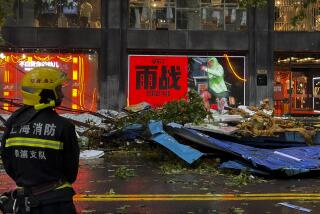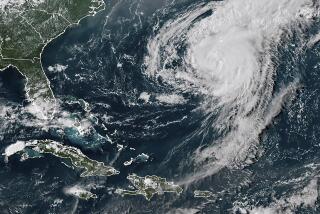Hurricane Ike batters Cuba for a second day
MIAMI -- Hurricane Ike tore into western Cuba today, dumping up to 20 inches of rain on already ravaged tobacco and sugar cane crops after its destructive romp across the length of the island that left four dead and forced the evacuation of 1.3 million.
Ike’s eye skipped south of the populous capital, Havana, where hundreds of thousands were moved to sturdier shelters from the crumbling apartments and bungalows that house most of the city’s 2.2 million residents.
Winds of 80 mph continued to rip apart dilapidated buildings, and rains drenched streets and alleys after the Category 2 storm raked the center of the island with 100 mph winds on Monday.
The death toll reported by state television was low but still surprising in the Communist-ruled country where authorities evacuate threatened areas with massive military and civil defense operations.
The National Hurricane Center in Miami reported Ike’s second Cuban landfall at 10:30 a.m. in Pinar del Rio Province, where cropland was savaged by Hurricane Gustav little more than a week ago. The center forecast rains of up to 20 inches and warned they could cause “life-threatening flash floods and mudslides over mountainous terrain.”
Residents in Texas and northern Mexico braced for Ike’s next wallop.
On Monday, Cuban revolutionary leader Fidel Castro proclaimed his country on “combat alert” against the third massive storm to hit the island in as many weeks and what he portrayed as a heartless double standard that blocks U.S. humanitarian aid.
The extent of Ike’s damage elsewhere in the Caribbean emerged on Monday, a day after it ravaged the Turks and Caicos Islands and the Bahamas as a Category 4 hurricane with winds upward of 135 mph. Ike had triggered more flooding in devastated Haiti, where the death toll from the series of storms was reported as high as 1,000.
In the important Cuban farming and mining areas near Camaguey, news agencies reported that the ferocious winds toppled buildings, including colonial columns that graced the city, a UNESCO-designated historical site.
Exiting into the Caribbean Sea after churning through the eastern provinces of Cuba, Ike slowed its forward motion to about 12 mph, and the hurricane center reported that its sustained winds had subsided to about 80 mph. It remained a Category 1 hurricane when it made its second Cuban landfall today, despite forecasters’ concerns it might intensify overnight when it crossed the warm waters off the island’s southern coast.
Haiti’s consul general for South Florida, Ralph Latortue, reported an even more dire state in his homeland than was apparent from the TV images showing bloated, mud-covered bodies stacking up at makeshift morgues along the flooded west coast. More than 1,000 people are feared to have died over the last month in inaccessible towns and villages, despite an official confirmed death toll of 391, he said. He also told journalists in Miami that 14,000 homes have been destroyed and 5 million people were left without food, water or shelter at times during the four-storm onslaught.
The U.S. Navy sent its amphibious assault ship Kearsarge to Port-au-Prince to assist in ferrying disaster relief to victims cut off by collapsed bridges and flooded towns along the sole road to stricken areas north of the capital. In contrast to the $100,000 in assistance offered Cuba, Washington gave Haitian storm victims $10 million. Bahamian Prime Minister Hubert Ingraham reported widespread damage to housing and landscape but no casualties in Great Inagua, where Ike hit Sunday.
There also were no confirmed casualties in the Turks and Caicos, although a survivor told the Associated Press on Grand Turk that 90% of the tiny island’s structures had been destroyed.
As Ike made its way westward across the 700-mile length of Cuba, it churned up five-story storm surges that blasted seaside towns and villages. Soldiers and civil defense volunteers moved more than 900,000 people from endangered areas inland to schools, hospitals and other fortified buildings. At least 9,000 foreign tourists were among those uprooted, and Cuban media reported that more evacuations had been ordered for the capital.
Evacuations are mandatory in Cuba, a policy the country’s Communist rulers say has prevented deaths and injury rampant in countries such as Haiti -- and the United States, in the case of Hurricane Katrina three years ago.
Raul Castro, the former defense minister who took over from his older brother Fidel as president in February, spent Monday directing the massive evacuation and public security operations from Havana in a conference call with the leaders of all 14 Cuban provinces, the Communist Party daily Granma reported.
Fidel Castro warned even before Ike hit that recovery costs would be in the billions for a nation in which the average monthly salary is less than $20.
Hurricane preparedness in Cuba, where there is rarely any loss of life despite the frequent battering, is one of Castro’s proudest achievements.
Information from the Associated Press was used in compiling this report.
More to Read
Sign up for The Wild
We’ll help you find the best places to hike, bike and run, as well as the perfect silent spots for meditation and yoga.
You may occasionally receive promotional content from the Los Angeles Times.







